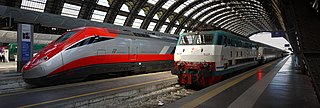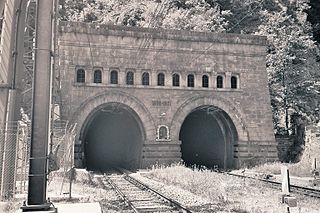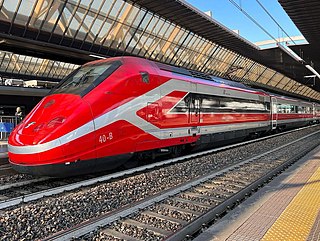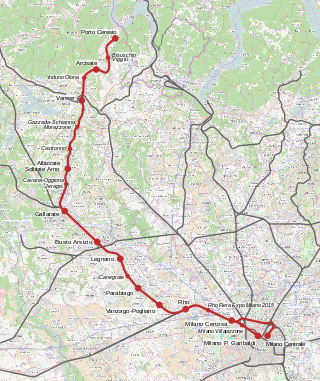| FS class E.420 | |||||||||||||||||||
|---|---|---|---|---|---|---|---|---|---|---|---|---|---|---|---|---|---|---|---|
 | |||||||||||||||||||
| |||||||||||||||||||
| |||||||||||||||||||
| |||||||||||||||||||
| |||||||||||||||||||
FS class E.420 locomotive was a third rail electric locomotive built for the operation of the Milan - Gallarate - Varese railway in Italy.
| FS class E.420 | |||||||||||||||||||
|---|---|---|---|---|---|---|---|---|---|---|---|---|---|---|---|---|---|---|---|
 | |||||||||||||||||||
| |||||||||||||||||||
| |||||||||||||||||||
| |||||||||||||||||||
| |||||||||||||||||||
FS class E.420 locomotive was a third rail electric locomotive built for the operation of the Milan - Gallarate - Varese railway in Italy.
The locomotive was ordered for the operation of the Milan - Gallarate - Varese railway line, electrified in 1901 by the Rete Mediterranea (RM). It was registered by the RM as RM.01 and was used for both passenger and freight traffic. In addition, twenty railcars were ordered.
In 1905 the locomotive was taken over by the Ferrovie dello Stato (FS). In the late 1920s, the locomotive was transferred from the Varese line to the Naples subway, to be used for freight traffic from Naples Campi Flegrei station. With the electrification at 3000 V DC of the Neapolitan line in 1937, it was transferred to the Cumana railway, which had been electrified in 1927. Here, it was converted to the 1200 V DC overhead line system and fitted with a pantograph. It remained in service until 1963.
The locomotive was built by General Electric and was similar to machines already in operation in the United States and Europe. In particular, it was similar to the E1-E8 series supplied to the French Compagnie du chemin de fer de Paris à Orléans and exhibited at the Exposition Universelle (1900) in Paris. The four traction motors totalled 440 kW, identical to that of the railcars delivered at the same time. At the maximum speed of 60 km/h, the locomotive could haul a train of eight four-wheel coaches. In appearance, the E.420 resembled the locomotives delivered to the Paris-Orléans railway, known as "salt boxes".

The Italian railway system is one of the most important parts of the infrastructure of Italy, with a total length of 24,227 km (15,054 mi) of which active lines are 16,723 km. The network has recently grown with the construction of the new high-speed rail network. Italy is a member of the International Union of Railways (UIC). The UIC Country Code for Italy is 83.

An electro-diesel locomotive is a type of locomotive that can be powered either from an electricity supply or by using the onboard diesel engine. For the most part, these locomotives are built to serve regional, niche markets with a very specific purpose.

The NER Class ES1 was a class of two steeplecab electric locomotives commissioned by the North Eastern Railway in 1902.

Steeplecab is railroad terminology for a style or design of electric locomotive; the term is rarely if ever used for other forms of power. The name originated in North America and has been used in Britain as well.
The New Zealand Railways Department, NZR or NZGR and often known as the "Railways", was a government department charged with owning and maintaining New Zealand's railway infrastructure and operating the railway system. The Department was created in 1880 and was corporatised on 1 April 1982 into the New Zealand Railways Corporation. Originally, railway construction and operation took place under the auspices of the former provincial governments and some private railways, before all of the provincial operations came under the central Public Works Department. The role of operating the rail network was subsequently separated from that of the network's construction. From 1895 to 1993 there was a responsible Minister, the Minister of Railways. He was often also the Minister of Public Works.
This is a list of jargon commonly used by railfans and railway employees in New Zealand.

The Italian railway system is one of the most important parts of the infrastructure of Italy, with a total length of 24,227 km (15,054 mi) as of 2011.

Trainkos, is the national railway company of Kosovo. It was originally formed as the Kosovo Railways J.S.C UNMIK Railways from the lines of the former Yugoslav Railways that lie on Kosovar territory. In 2011, the company was split into two public companies called Trainkos and Infrakos, the latter responsible for rail maintenance.

Line 2 is a rapid transit service operated by Trenitalia in the city of Naples, Italy. It connects 12 stations.

The Domodossola–Milan railway line is a major Italian railway route and an important part of the European rail network. It is one of Italy's busiest lines for both passenger and freight trains. The line connects Milan and Domodossola with Brig, an important Swiss railway junction, via the Simplon Tunnel. Direct passenger trains ran from Brig to Paris and Brussels and Luxembourg via Basel. The line runs through lower Varese Province, the valley of Ossola and along the shore of Lake Maggiore.

Milano Porta Garibaldi is a major railway station in the Italian city of Milan, located just to the north of the neighbourhood known as Porta Garibaldi. Porta Garibaldi is the city's main station for commuter traffic with 25 million passengers annually, although it is second to Centrale station considering total passenger traffic. The station is located on Piazza Sigmund Freud.

The Brenner Railway is a major line connecting the Austrian and Italian railways from Innsbruck to Verona, climbing up the Wipptal, passing over the Brenner Pass, descending down the Eisacktal to Bolzano/Bozen, then further down the Adige Valley to Rovereto/Rofreit, and along the section of the Adige Valley, called in Italian the “Vallagarina”, to Verona. This railway line is part of the Line 1 of Trans-European Transport Networks (TEN-T). It is considered a "fundamental" line by the state railways Ferrovie dello Stato (FS).

The BB 1 to 80 are electric locomotives of the former Paris-Orléans company, taken over by the SNCF at its creation in 1938.
Tecnomasio was an Italian scientific and precision instrument company founded in the 1860s. By the beginning of the 20th century the company has begun to produce electrical equipment. After financial problems in the early 1900s the company was acquired by Brown Boveri becoming Tecnomasio Italiano Brown Boveri commonly known as TIBB; instrument production halted and the company became an industrial electrical equipment producer, one of the major companies in Italy.

ETR 500 is a family of Italian high-speed trains built by AnsaldoBreda and introduced in 1993.

Porto Ceresio–Milan railway is a railway line in Lombardy, Italy. It uses the tracks of the Milan–Arona railway until Gallarate.

The FS Class E.430 locomotives, initially classed as RA 34, were three-phase alternating current electric locomotives of the Italian railways. They were built for Ferrovia della Valtellina by Ganz and MÁVAG in 1901 and had a power output of 440 kW and a haulage capacity of 300 tons. One locomotive is preserved.

FS Class E.321 was a class of 17 third-rail electric locomotives, built for the Italian State Railways (FS) for operation on the Varese line and on the underground line in Naples.

FS Class E.220 was a two-axle electric locomotive, powered by a third rail, built for operation on the Varese line of the Italian Rete Mediterranea and registered as RM 02. It was acquired by the Italian State Railways in 1918 and re-registered as 220.01. It remained a unique example.
The Naples–Foggia railway is an Italian railway line connecting Naples, in Campania, with Foggia, in Apulia, crossing the Apennines at the saddle of Ariano through a series of tunnels.